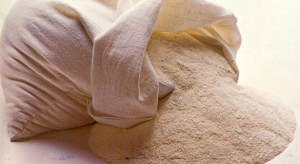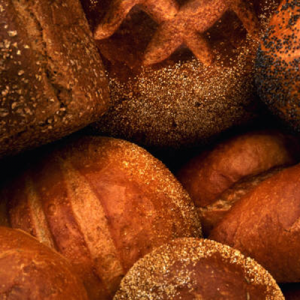Gluten is one of the major proteins found in wheat. Gluten is also found in other grains such as: spelt, kamut, triticale, barley, rye, and malts (and oatmeal). But if you really want to avoid gluten you also have to look out for food additives as stabilizers, flavorings, or even thickening agents that contain gluten.

The word “gluten” comes from Latin and means “glue” and while your digestive system is not a fan of gluten, it is what makes wheat such a great grain to cook with. If you want light and fluffy breads you need to have something to hold the grain particles together and gluten does that really well. Breads rise when you add yeast to gluten-containing flours because gluten holds the bread together. When you see the pizza guy twirling a crust in the air he can do that because gluten is holding it together. If you grind rice and try and make dough, all you get is a messy pizza guy with rice dough on his face.
Cooks, scientists and farmers all wanted to have wheat with more gluten and the food scientists actually bred wheat to contain more gluten than found in nature. The result is that our wheat today has a ton of gluten in is and while pastry chefs all over the world applauded this move, our tummies do not.
Why does gluten cause problems?
Gluten intolerance is an immune problem; many people’s gut immune system simply doesn’t like gluten and reacts to it. This is due, in part, to the high gluten content in the grains we eat, but also because we eat so much of it. When was the last time you went a meal without eating some form of wheat?
There are people who have full-blown allergic reaction to gluten and these people have Celiac disease. But what I see more often than people with a full-blown reaction to gluten is what I would call gluten sensitivity or gluten intolerance. Common problems that I see in people who are sensitive or intolerant to gluten are sinus problems allergies, digestive problems including gas, bloating, diarrhea and problems concentrating and others.
What can you do about gluten intolerance?
The only real answer to gluten intolerance is to avoid gluten and go on a gluten-free diet. The best way to do this is to avoid gluten and gluten products for at least two weeks. When you avoid these products for at least two weeks, then your body has a chance to repair all the damage done by the overactive immune system.
Flours that you can bake with that seem to work are corn, potatoes, rice, and tapioca, amaranth, arrowroot, millet, quinoa, sorghum, sweet potato, taro, teff, chia seed, and yams. (see Baking with Non-Gluten Grains)
But I wouldn’t stop there. If you are having digestive problems then I would also remove other common allergens such as dairy foods and corn.
If you are really crazy (and maybe want to lose some weight) try my 30 Sugar Free Days Program where people stay away from not only sugar but foods that act like sugar (that means all grains).











